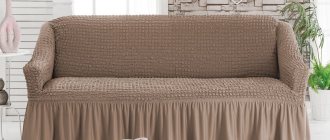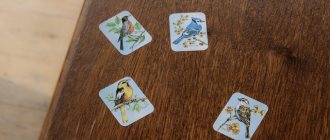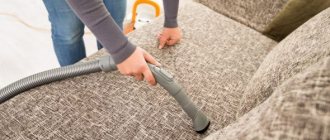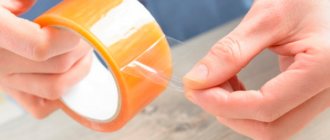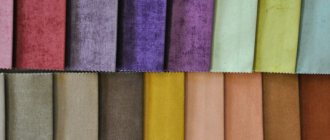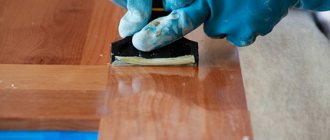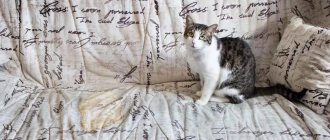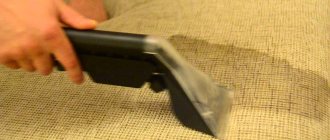Removing stains from the sofa
Cleaning the house is a labor-intensive process that requires not only physical strength, but also certain skills and knowledge.
Sometimes upholstered furniture, which has served you faithfully for many years, begins to need care.
It is especially important to understand the intricacies of cleaning dust, dirt and stains from upholstered furniture. And if you don’t know how to remove stains from a sofa, then this article will find the answers to this question.
Stock up on sofa cleaning products and patience.
What causes stains on the sofa?
In any room, despite the frequency and intensity of cleaning, dust accumulates on surfaces. Sofas and easy chairs are no exception.
Cleaning upholstered furniture more often is a rule of a good housewife.
And if you wipe the dust from the upholstery of such furniture without following certain rules, you can see whitish stains or the outlines of stains on the upholstery fabric.
Sometimes such a nuisance occurs due to insufficient removal of detergent from the surface. Sometimes stains remain after drying, especially if it contains a lot of salts.
Sometimes stains on sofas appear from food.
Most often, stains remain on the upholstery of upholstered furniture if the felt, foam rubber and padding polyester used to cover the sofa frames are excessively wet.
How to get rid of divorces using folk remedies
Removing the unsightly consequences of cleaning the surface of your home sofa is actually quite simple. To do this, you can use available folk remedies or store-bought stain removers.
Partial cleaning of the sofa is a mistake that many housewives make. But first, thoroughly clean the upholstery fabric from dust. Use a vacuum cleaner with a special attachment or brush. Alternatively, cover the sofa with a damp sheet and carefully beat out any dust, hair and lint with a regular carpet beater.
There are special devices for cleaning upholstered furniture.
Note! Don't overdo it with water in this situation. Your task is to slightly moisten the surface so that the dust does not fly away, but sticks to the wet sheet. If you wet the filling, the stains will become even more noticeable.
Most detergents perfectly clean the surface of grease, paint, and drinks.
When you are sure that the dust has been removed, take a spray bottle, add clean water and ammonia, spray the liquid onto the contaminated areas and carefully go over the fabric with a brush or stiff sponge.
Serious stains can be removed using detergent and a stiff sponge.
If the edges of the stains or streaks are still visible, add a spoonful of vinegar to the water and alcohol solution and repeat the procedure. After this, the surface needs to be dried, the faster the better. Alternatively, use a regular household hair dryer, but not an iron.
It is easier to clean upholstered furniture with special devices.
If stains remain due to the use of inappropriate detergents (with fragrances or dyes), a sponge generously soaped with simple laundry soap will help remove the stains.
Laundry soap is a good and cheap cleaning product.
But for many housewives, ordinary baking soda has become the most faithful assistant in cleaning the house. In some situations, dry cleaning will help get rid of dirt.
Dry cleaning can also remove stains.
It is enough to cover the dirty stain with dry soda, leave it for a while, and then remove the powder and dirt with a vacuum cleaner!
Important! You should not leave baking soda on the surface of the furniture for a long time - the powder will begin to absorb moisture from the environment and this will lead to the appearance of new stains, an unpleasant odor, or the development of fungus and mold.
To enhance the cleansing effect, soda can be mixed with other available and effective means.
Baking soda is a cheap detergent.
Try vinegar and baking soda for cleaning
If you don’t have ammonia on hand or it doesn’t help, you can make a cleaning solution from vinegar and soda. You will need 5 liters of warm water, 1 glass of vinegar and 4 tablespoons of soda. First rub the edge of the upholstery fabric with the resulting product to check the reaction.
Table vinegar also effectively fights stains.
If there are no visible changes, soak a sheet or a piece of natural (cotton or linen) fabric in the solution and beat the surface again. Sometimes you will need to repeatedly soak the cloth in the cleaning solution and beat out the upholstery. If that doesn't help, wipe the stain with a mixture of vinegar and baking soda. And dry again.
You can dry it with a vacuum cleaner.
Hydrogen peroxide and soda
A mixture of hydrogen peroxide and baking soda perfectly removes some traces of dirt. Mixing proportions are 2:1 respectively.
Hydrogen peroxide is a good stain remover.
Using the resulting mixture, thoroughly wipe the contaminated surface with a sponge or napkin, and then remove the remaining mixture with a damp sponge. Dry vigorously.
Products for light upholstery
Sometimes yellowish shades from stains are not immediately visible on a light color. In order to remove stains from the sofa, use the following folk recipes:
- Baking soda mixed with water. The paste is applied to the damaged area.
- Vinegar 9% diluted one to one in water.
- Hydrogen peroxide. Used even in its pure form, it neutralizes blood.
- Ammonia. Helps get rid of unpleasant odors.
- Citric acid or juice. Removes unwanted aroma.
Use of special means
If folk and improvised means do not give the desired result, you need to switch to “heavy artillery”.
Wet cleaning is very effective.
Purchase special products - stain removers for carpets and home textiles. The main thing is to use a special product suitable for your furniture (for example, suede, microcorduroy, velor, plush, etc.).
Vanish is an excellent cleaner not only for stains, but also for unpleasant odors.
There are also universal stain removers on sale, for example, Vanish or Sano. The Karcher brand offers a large selection of auxiliary cleaning products.
You need to use special household chemicals according to the instructions. If the manufacturer indicates on the label the proportions or dosage for dilution, do not violate the instructions. Otherwise, you may damage the upholstered furniture or not achieve the desired result.
Now you know how easy it is to remove whitish stains from your sofa after cleaning. But in fact, it’s easier to prevent their appearance - just thoroughly vacuum the surfaces before wet cleaning and do not wet the upholstery with large amounts of water.
Relax after cleaning your couch!
Ready-made chemicals
You can also clean the sofa with chemicals. While studying the sofa cleaning product, we familiarize ourselves with its description and rules of use. The description indicates what type of fabric it is intended for:
- "Vanish " The line of this product includes shampoo, antibacterial agent and powder. For coatings that do not tolerate moisture, we use the latter (cleaning using the dry method);
- "Marseille Soap" . Contains olive oil and baking soda. Used to clean small stains. Wet the soap, rub the stained area and after 20 minutes rinse with a damp cloth;
- "Denkmit" - foam for cleaning carpet and sofa upholstery. We use it for velvet, tapestry and silk coverings;
- "Sama " Effectively fights old stains, dirt and bacteria;
- Bagi "Shtihonit" . We use it as a stain remover and as a complete cleaning agent;
We also recommend that all housewives find out how to wash kitchen towels from old grease stains and odors.
- "Pro Brite " An environmentally friendly product, suitable for people with allergies. It has a sprayer that is convenient for applying the product to local areas of the upholstery;
- "Dufta" , "Simple Solution" , "Nature's Miracle" . These products effectively combat unpleasant odors and completely eliminate them.
How to remove water stains from a sofa?
Sometimes after cleaning your sofa you need to clean it again due to streaks.
This is due to the fact that most detergents perfectly clean the surface of grease, paint, and drinks. But the components in the composition may remain white stains, which spoils the appearance no less. And removing them is much more difficult. Usually they are not washed off with water, which makes the event much more difficult. There are a number of ways to avoid divorce. For example, wash the entire sofa so that a certain area does not stand out. However, this is not always possible, since action is not a panacea. But how to remove stains from the sofa after cleaning?
After cleaning the sofa there are still stains, what should I do?
There is a fairly simple recipe for how to remove stains after cleaning. To do this, you will need ingredients that you have in your kitchen. It is important to note that this technology is not suitable for all sofas. The mixture contains acetic acid, which can react with the paint, causing it to fade. Therefore, before applying, check the composition on the edge of the upholstery so as not to spoil the entire furniture.
To get rid of divorces, do the following.
1. For five liters of warm water, take one glass of 6 percent vinegar and four tablespoons of soda. Mix the ingredients and wait for the reaction to complete.
2. Take a discarded sheet and soak it generously in the mixture. After this, wring out the fabric so that no water drips from it.
3. Cover the sofa with fabric so that it covers all areas of the furniture and begin to lightly beat. You can use a carpet beater for such measures. You don't need to hit it too hard so as not to damage the upholstery.
This method is the simplest and cheapest. It does not require household chemicals and is prepared using ingredients that everyone has in their kitchen. However, it does not always work. If you use cheap sofa cleaning products, traces of fragrance or dye can be corrosive and deeply absorbed into the fabric. This will not allow them to be destroyed by such a primitive method. Stains may be due to salts in your cleaning product or fragrance. In this case, you will have to resort to using household chemicals, preferably in an expensive price segment. Regular Vanish will do, as it works great for cleaning stains. You can also take more expensive means.
1. Dilute the composition according to the instructions. If it turns out thick, dilute it with additional water so that you can refill the sprayer. This does not require a lot of product, since we need to evenly cover the entire surface of the sofa.
2. Spray the mixture over the entire surface. It is necessary to apply not only to areas of stains. Don't overdo it - just make the surface a little damp. There is no need to scrub it with a brush or rag.
3. Hang the fabric on top. If you don't want to wait for it to dry completely, you can use a hairdryer to speed up the evaporation of the liquid. It is advisable to use cotton or linen, but synthetics are allowed.
In some cases this may not give the desired result. Try the procedure again. If you don’t want to get rid of stains on your own, sofa dry cleaning in Moscow will help you, which gives an excellent effect. Any streaks and stains after cleaning the sofa will be removed in a short time. Using professional products allows you to carefully clean the surface without leaving additional marks. The cost of a one-time procedure is much less than the time spent on upgrading your sofa.
How to prepare furniture for cleaning
Before you begin removing stains, upholstered furniture should be vacuumed to remove dust. If the stains are of different types or the contamination is too strong, you can use several different products, but not at the same time. Apply one first, let it develop for a few hours, and only then try another.
If you have doubts about the sofa cleaner, it is better to conduct experiments on a small, inconspicuous piece of upholstery. This way you can protect yourself from damaging the entire sofa.
If the manufacturer has indicated any recommendations for the use and cleaning of the material with which your sofa is upholstered, do not neglect them in any case.
Ideally, upholstered furniture is vacuumed once a week, knocked out about once a quarter, and covers are washed once every six months. It is advisable to remove stains immediately after they appear, so that the stain does not become embedded in the fibers of the fabric.
How to clean a sofa from stains and stains on your own?
The easiest way, of course, to clean the sofa from stains on a dry basis - felt-tip pens, grease, grass, lipstick. But the so-called “wet” stains are more difficult to remove, since you must first try to dry them.
As a rule, stains can “blur” and increase in size if they are not removed correctly:
Most often, after divorces it is more difficult to “reanimate” the sofa, especially if the urine stain is washed away. The difficulty is that it is much more difficult to clean a sofa from stains and stains of this origin, since the area where the smell spreads also increases.
Cleaning with a vacuum cleaner
This method is suitable if you need to get rid of dust, hair and bed mites. But, alas, it will not help with stains or unpleasant odors.
Most vacuum cleaners come with attachments for carpets and upholstered furniture. They must have special thread-lifting strips, which in addition comb the fibers and lift them.
There is also an attachment for orthopedic mattresses and upholstered furniture. Thanks to the high air flow speed, it can be used to remove dust even from the deep layers of thick mattresses.
A washing vacuum cleaner will help you clean the sofa from stains without streaks. It comes complete with a special nozzle designed for cleaning upholstered furniture. It does its job no worse than a sponge and shampoo, and you need to put in much less effort. Thanks to the special design, water does not penetrate deep into the sofa and only washes the top layer.
How to clean a sofa from stains quickly and without streaks?
Most fresh stains can be removed with a simple dish detergent (such as Fairy or 72% laundry soap). For difficult stains (for example, cat urine), you will need special products or several home remedies that will help both decompose the odor and remove the stain.
It is important to remember that not all available products are equally good for both light and dark upholstery. For example, ammonia can slightly lighten a dark fabric, and iodine can darken a light one. Therefore, so that you don’t have to think about how to clean the sofa from stains later, you need to:
If, despite all your efforts, there are still unpleasant stains on the sofa, then specialists will help you remove them. Thanks to the latest hypoallergenic products and powerful equipment, cleaning your sofa at home will give excellent results. This type of dry cleaning will help with heavily stained sofas, remove stained areas, restore the original color and get rid of accumulated unpleasant odors. In addition, professional cleaning is a means of preventing the appearance of dust mites and harmful microorganisms.
Which fabrics are easier to remove stains from: choosing upholstery for a sofa
In the first place are genuine furniture leather and good leather substitutes (they can be easily washed with a damp cloth and natural soap). If there are children and pets in the house, then the best choice would be flock, which has good qualities of strength and resistance to stains (dry cleaning) and jacquard (dry cleaning), microfiber cloths (easy to clean). This is followed by tapestry (durable, can be washed or dry cleaned), velor (easy to clean, only dry cleaning is suitable) and suede (necessarily with a special impregnation, cleaned either with wet or dry cleaning). Another option is to purchase a sofa with removable upholstery. The easiest way to keep the sofa upholstery safe and sound is to cover it with a blanket immediately after purchase.
It is almost impossible to remove stains without streaks from some types of fabrics. For example, artificial suede, chlorine and acetate fabrics.
General recommendations and advice
When talking about how to clean a sofa from old stains and dirt, it is worth determining the type of material from which the upholstery is made :
- products made from genuine leather and leather substitutes cannot be cleaned using an iron, hair dryer, very hot liquids, as well as powders and other household chemicals containing abrasive particles;
- furniture upholstered in flock or velor cannot be cleaned with chemicals or household products containing alcohol;
- jacquard and chenille, as well as matting and microfiber cannot be too wet, so wet or dry cleaning is recommended;
- Furniture with light upholstery should be cleaned with light-colored napkins or fabrics, as colored materials can fade;
- tapestry cannot be wet, so it is cleaned with a vacuum cleaner, suede - with a brush.
How to remove a stain from a sofa: comparison table of products
Homemade upholstery stain removers work well on many stains:
Ways to reduce spots
Dirt, stains on furniture leather, white leather sofa
Dilute 1 egg in 1/2 glass of milk, wipe the sofa with a damp cloth, stubborn dirt will disappear.
Immediately sprinkle with salt. Let dry, then clean and vacuum. Wash the white wine stain with an aqueous solution of methyl alcohol (3 parts alcohol, 1 part water), dry, wash with a solution of mild soap and water and dry. Red wine stains can be washed off with... white wine! Then do the same as with a white wine stain (it's easier).
If the blood has not yet dried, it can be easily washed off with cold (!) water. Dried blood can be reduced with a solution of aspirin tablets in a glass of water. You can also wash it afterwards with water and laundry soap. If the stain is dry, wash with a solution of cold water and salt (1 tablespoon per liter). Hydrogen peroxide on cotton wool is also suitable (be sure to test on a piece of fabric that is not visible). Sometimes toothpaste can help, but not on all types of fabric.
Stains from pens, felt-tip pens, pencils
Removed with a special furniture shampoo. A wax crayon stain can be removed by placing loose paper and ironing it, changing the paper (or napkin). Regular pencil marks can be washed off with hot water and dishwashing liquid. Acetone and alcohol can also help, but not on all types of upholstery. Lemon juice does not remove the handle from fabric well, hairspray can ruin fabric upholstery.
It is better to immediately cover fresh stains with salt (or potato starch, chalk, talcum powder) and change it several times. You can iron it with an iron through a cloth. Fats also dissolve the following substances: gasoline, ether, acetone, alcohol, purified turpentine. One of the solvents can be mixed with talc or starch and put a cloth on the stain. But you cannot apply these products directly to the fabric of the sofa (only on a cloth) and in the required proportions, otherwise you can simply ruin the sofa.
Stains of greenery, iodine
For leather sofas: a mixture of washing powder and ammonia. But it is preferable to use special means. It is also recommended to drop bleach onto the stain and then scrub with a brush, or an ammonia solution (10%).
Acrylic paints can be easily washed with cold water from household items. soap or acrylic paint thinner. Oil paints are reduced with paint thinner. Be sure to test it on another similar piece of fabric! (Acetone may increase the stain.)
Wash with mild soap or warm salt water and dry with a soft cloth.
If the glue is PVA, place a very wet rag on the stain and hold it, the glue will soften and you can wipe it off. Other types of glue: soak the glue with a cotton swab containing Anti-Glue (sold in tubes as glue).
Iron on low setting through paper or a cloth, then carefully scrape off. If a stain remains, sprinkle with chalk or talcum powder and iron again. It's even better to use a special stain remover. On plush and velvet, stains are removed with alcohol or turpentine, but do not iron, so as not to spoil the lint of the fabric.
Place the ice in the bag on the chewing gum; when it hardens, peel it off. Wipe with a cloth soaked in methyl alcohol, cover with a clean, dry cloth and let dry.
Fruit juices can be washed with a solution of ammonia and white vinegar (1:1), jam and preserves can be washed with a soapy solution and vinegar. A solution of a mixture of ammonia and vinegar also works.
Lipstick stains
Use a cloth soaked in ammonia (turpentine) to wipe the stain, place a dry cloth or napkin on top and iron at low temperature. It will also help to apply a mixture of lemon and soda (half a lemon and a little soda) to the stain, let it dry and clean with a brush.
Removed with soap solution.
Immediately get wet, dry, then treat with 1-2 tbsp. l. white vinegar per 1 liter of water.
Stains from sweet drinks, milk, ketchup
Rinse immediately with warm water.
Vinegar solution or foam detergent.
Pour in baking soda, wipe after 15 minutes, then dilute a solution of one teaspoon of vinegar and four tablespoons of water. You can first fill it with the solution and add baking soda on top. The entire sofa can be washed with the same solution to refresh the color and remove small stains.
Fucorcin stain
Folk remedy: mix tooth powder and alcohol in half, apply to the stain, let dry, vacuum. Fukortsin becomes discolored when the stain is treated with sodium sulfite solution. But it cannot be left on the fabric! It is imperative to wash or neutralize (especially acidic solutions) with a soda solution.
Wet with a damp cloth, and then dry from the center to the edges with a hairdryer, using circular movements, while constantly wiping the edges of the stain with a damp cloth.
Some types of ink are removed by tomato juice, alcohol, and denatured alcohol. But it’s better not to experiment and purchase a special product.
The best time to remove stains is when they are still fresh. Dried stains are more difficult to remove. Apply the stain remover first to a small piece of the sofa upholstery in an inconspicuous place to ensure that the color does not change.
Features of cleaning different types of upholstery
There are several groups of fabrics that require a special approach to cleaning.
Faux suede and nubuck
It is convenient to care for such upholstery using a vacuum cleaner, a clothes brush and a soap solution. To restore the volume of the fabric after cleaning, comb it with a rubber brush.
Be careful when choosing chemicals for suede, as some can ruin the appearance.
Genuine leather and leatherette
Dust and dirt from the surface of leather furniture can be removed with a dry cloth. Once a year you need to treat such furniture with a special compound or stearic ointment. It creates a protective film on the skin, preventing it from becoming dirty and damaged.
Eco leather is easier to clean. Stains such as coffee, wine, tea, and fruit juice can be easily removed with an ordinary soap solution. Remove marker stains with a cotton pad soaked in alcohol.
Remember that such products do not tolerate moisture well. Therefore, at the end of wet cleaning, arm yourself with a dry cloth and wipe the furniture.
Tapestry
It is better to dry clean this fabric. This way you will accurately preserve the color of the upholstery and the shape of the upholstered furniture. If you still need more serious cleansing, then use lukewarm water with added shampoo. In this case, do not apply the solution itself to the fabric, but only the foam.
Flock, velor fabric, matting
At home, you can use washing powder or washing gel. Make a soap solution, soak a sponge in it and carefully walk over the surface of the upholstered furniture. Wait 20-30 minutes and remove the product with a clean sponge or vacuum cleaner.
It is good to clean food stains with water and a few drops of lemon juice. Apply the resulting solution to the stain and wait 10-15 minutes. Finally, rinse the fabric with a damp, clean sponge.
Light fabrics
For such upholstery, it is better to use professional products for upholstered furniture or use the services of a cleaning company. If the stain doesn’t come out, don’t despair. Try turning it into a fantasy drawing with strong brewed black tea or coffee. Or just order a new sofa cover.
Maria Yuryevna was able to clean her sofa of stains. But after such an “adventure” I decided to order a removable cover for all upholstered furniture. It is much easier to wash, and if the stains cannot be removed, you can always order a new one.
Rules for cleaning a sofa yourself
1. When cleaning a sofa with a vacuum cleaner, you can wrap the brush in gauze and moisten it in a salt solution (1 tsp per 1 liter of water). This method allows you to update the color.
2. Velvet and plush upholstery should not be vacuumed.
3. It is better to apply the cleaning agent not to the fabric itself, but to a cloth, or even better - through a thin layer of gauze or other thin fabric.
4. Clean the stain with a rag from the center of the stain outward.
5. You should not use multiple chemicals. funds.
6. Clean in the direction of the fabric fibers.
7. Fresh stains cannot be immediately rubbed with stain removers! It is better to use warm or cold water, depending on the source of the stain.
How to dry clean a sofa at home?
Pour 1/3 cup of vinegar and 0.5 liters of water into a spray bottle. Add 1 tablespoon of baking soda. Close the spray bottle and spray the solution onto the sofa in a neat, even layer. Leave the composition on the surface for 10-15 minutes, then scrub with a brush or medium-hard sponge.
Interesting materials:
What is the maximum amount of child support that can be paid? How long to marinate lamb? How much melatonin can you take? How many months should a cow be in the run before calving? How much meat from one bull? What is the minimum wage in the Altai region? How many ml of perfume can you carry in hand luggage? How much can be deducted from a pension based on a writ of execution? How long can you keep broccoli in the refrigerator? How long can you store boiled cauliflower?
Which fabrics are easier to remove stains from: choosing upholstery for a sofa
In the first place are genuine furniture leather and good leather substitutes (they can be easily washed with a damp cloth and natural soap). If there are children and pets in the house, then the best choice would be flock, which has good qualities of strength and resistance to stains (dry cleaning) and jacquard (dry cleaning), microfiber cloths (easy to clean). This is followed by tapestry (durable, can be washed or dry cleaned), velor (easy to clean, only dry cleaning is suitable) and suede (necessarily with a special impregnation, cleaned either with wet or dry cleaning). Another option is to purchase a sofa with removable upholstery. The easiest way to keep the sofa upholstery safe and sound is to cover it with a blanket immediately after purchase.
It is almost impossible to remove stains without streaks from some types of fabrics. For example, artificial suede, chlorine and acetate fabrics.
How to remove a stain from a sofa: comparison table of products
Homemade upholstery stain removers work well on many stains:
Ways to reduce spots
Dirt, stains on furniture leather, white leather sofa
Dilute 1 egg in 1/2 glass of milk, wipe the sofa with a damp cloth, stubborn dirt will disappear.
Immediately sprinkle with salt. Let dry, then clean and vacuum. Wash the white wine stain with an aqueous solution of methyl alcohol (3 parts alcohol, 1 part water), dry, wash with a solution of mild soap and water and dry. Red wine stains can be washed off with... white wine! Then do the same as with a white wine stain (it's easier).
If the blood has not yet dried, it can be easily washed off with cold (!) water. Dried blood can be reduced with a solution of aspirin tablets in a glass of water. You can also wash it afterwards with water and laundry soap. If the stain is dry, wash with a solution of cold water and salt (1 tablespoon per liter). Hydrogen peroxide on cotton wool is also suitable (be sure to test on a piece of fabric that is not visible). Sometimes toothpaste can help, but not on all types of fabric.
Stains from pens, felt-tip pens, pencils
Removed with a special furniture shampoo. A wax crayon stain can be removed by placing loose paper and ironing it, changing the paper (or napkin). Regular pencil marks can be washed off with hot water and dishwashing liquid. Acetone and alcohol can also help, but not on all types of upholstery. Lemon juice does not remove the handle from fabric well, hairspray can ruin fabric upholstery.
It is better to immediately cover fresh stains with salt (or potato starch, chalk, talcum powder) and change it several times. You can iron it with an iron through a cloth. Fats also dissolve the following substances: gasoline, ether, acetone, alcohol, purified turpentine. One of the solvents can be mixed with talc or starch and put a cloth on the stain. But you cannot apply these products directly to the fabric of the sofa (only on a cloth) and in the required proportions, otherwise you can simply ruin the sofa.
Stains of greenery, iodine
For leather sofas: a mixture of washing powder and ammonia. But it is preferable to use special means. It is also recommended to drop bleach onto the stain and then scrub with a brush, or an ammonia solution (10%).
Acrylic paints can be easily washed with cold water from household items. soap or acrylic paint thinner. Oil paints are reduced with paint thinner. Be sure to test it on another similar piece of fabric! (Acetone may increase the stain.)
Wash with mild soap or warm salt water and dry with a soft cloth.
If the glue is PVA, place a very wet rag on the stain and hold it, the glue will soften and you can wipe it off. Other types of glue: soak the glue with a cotton swab containing Anti-Glue (sold in tubes as glue).
Iron on low setting through paper or a cloth, then carefully scrape off. If a stain remains, sprinkle with chalk or talcum powder and iron again. It's even better to use a special stain remover. On plush and velvet, stains are removed with alcohol or turpentine, but do not iron, so as not to spoil the lint of the fabric.
Place the ice in the bag on the chewing gum; when it hardens, peel it off. Wipe with a cloth soaked in methyl alcohol, cover with a clean, dry cloth and let dry.
Fruit juices can be washed with a solution of ammonia and white vinegar (1:1), jam and preserves can be washed with a soapy solution and vinegar. A solution of a mixture of ammonia and vinegar also works.
Lipstick stains
Use a cloth soaked in ammonia (turpentine) to wipe the stain, place a dry cloth or napkin on top and iron at low temperature. It will also help to apply a mixture of lemon and soda (half a lemon and a little soda) to the stain, let it dry and clean with a brush.
Removed with soap solution.
Immediately get wet, dry, then treat with 1-2 tbsp. l. white vinegar per 1 liter of water.
Stains from sweet drinks, milk, ketchup
Rinse immediately with warm water.
Vinegar solution or foam detergent.
Pour in baking soda, wipe after 15 minutes, then dilute a solution of one teaspoon of vinegar and four tablespoons of water. You can first fill it with the solution and add baking soda on top. The entire sofa can be washed with the same solution to refresh the color and remove small stains.
Fucorcin stain
Folk remedy: mix tooth powder and alcohol in half, apply to the stain, let dry, vacuum. Fukortsin becomes discolored when the stain is treated with sodium sulfite solution. But it cannot be left on the fabric! It is imperative to wash or neutralize (especially acidic solutions) with a soda solution.
Wet with a damp cloth, and then dry from the center to the edges with a hairdryer, using circular movements, while constantly wiping the edges of the stain with a damp cloth.
Some types of ink are removed by tomato juice, alcohol, and denatured alcohol. But it’s better not to experiment and purchase a special product.
The best time to remove stains is when they are still fresh. Dried stains are more difficult to remove. Apply the stain remover first to a small piece of the sofa upholstery in an inconspicuous place to ensure that the color does not change.
Treatment of blood stains
Blood stains and marks are considered one of the most difficult to remove. A fresh stain is easier to remove, but sometimes you have to deal with old stains. There are several options for dealing with blood stains when plain water does not help remove them even in several steps:
- you need to prepare a salt solution from two teaspoons and a glass of water, which is then applied to the sofa with a spray bottle and immediately wiped with a dry cloth.
- if the stain is large and dry, apply pharmaceutical peroxide to the upholstery, then blot the area with a napkin and repeat until it stops bleeding;
- ammonia also works well with blood, but you need to be more careful with leather - such upholstery can be seriously damaged by ammonia.
It is better to clean the stain fresh

